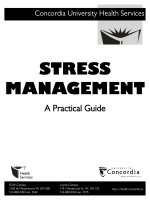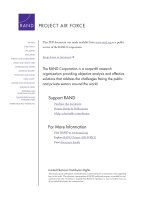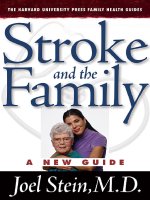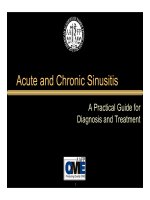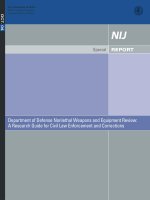Workforce Planning and Development Processes - A Practical Guide ppt
Bạn đang xem bản rút gọn của tài liệu. Xem và tải ngay bản đầy đủ của tài liệu tại đây (945.77 KB, 70 trang )
This document and trademark(s) contained herein are protected by law as indicated in a notice appearing
later in this work. This electronic representation of RAND intellectual property is provided for non-
commercial use only. Permission is required from RAND to reproduce, or reuse in another form, any
of our research documents for commercial use.
Limited Electronic Distribution Rights
This PDF document was made available from www.rand.org as a public
service of the RAND Corporation.
6
Jump down to document
THE ARTS
CHILD POLICY
CIVIL JUSTICE
EDUCATION
ENERGY AND ENVIRONMENT
HEALTH AND HEALTH CARE
INTERNATIONAL AFFAIRS
NATIONAL SECURITY
POPULATION AND AGING
PUBLIC SAFETY
SCIENCE AND TECHNOLOGY
SUBSTANCE ABUSE
TERRORISM AND
HOMELAND SECURITY
TRANSPORTATION AND
INFRASTRUCTURE
WORKFORCE AND WORKPLACE
The RAND Corporation is a nonprofit research
organization providing objective analysis and effective
solutions that address the challenges facing the public
and private sectors around the world.
Visit RAND at www.rand.org
Explore RAND Project AIR FORCE
View document details
For More Information
Purchase this document
Browse Books & Publications
Make a charitable contribution
Support RAND
This product is part of the RAND Corporation technical report series. Reports may
include research findings on a specific topic that is limited in scope; present discus-
sions of the methodology employed in research; provide literature reviews, survey
instruments, modeling exercises, guidelines for practitioners and research profes-
sionals, and supporting documentation; or deliver preliminary findings. All RAND
reports undergo rigorous peer review to ensure that they meet high standards for re-
search quality and objectivity.
Workforce Planning and
Development Processes
A Practical Guide
Georges Vernez, Albert A. Robbert,
Hugh G. Massey, Kevin Driscoll
Prepared for the United States Air Force
Approved for public release; distribution unlimited
The RAND Corporation is a nonprofit research organization providing objective analysis
and effective solutions that address the challenges facing the public and private sectors
around the world. RAND’s publications do not necessarily reflect the opinions of its
research clients and sponsors.
R
®
is a registered trademark.
© Copyright 2007 RAND Corporation
All rights reserved. No part of this book may be reproduced in any form by any electronic or
mechanical means (including photocopying, recording, or information storage and retrieval)
without permission in writing from RAND.
Published 2007 by the RAND Corporation
1776 Main Street, P.O. Box 2138, Santa Monica, CA 90407-2138
1200 South Hayes Street, Arlington, VA 22202-5050
4570 Fifth Avenue, Suite 600, Pittsburgh, PA 15213-2665
RAND URL: />To order RAND documents or to obtain additional information, contact
Distribution Services: Telephone: (310) 451-7002;
Fax: (310) 451-6915; Email:
The research described in this report was sponsored by the United States Air Force under
Contract F49642-01-C-0003 and FA7014-06-C-0001. Further information may be
obtained from the Strategic Planning Division, Directorate of Plans, Hq USAF.
Library of Congress Cataloging-in-Publication Data
Workforce planning and development processes : a practical guide / Georges Vernez [et al].
p. cm.
Includes bibliographical references.
ISBN 978-0-8330-4006-0 (pbk. : alk. paper)
1. United States. Air Force—Personnel management. 2. Manpower—United States. I. Vernez, Georges.
UG773.W67 2007
358.4'1610973—dc22
2007000929
iii
Preface
e Air Force Materiel Command (AFMC) is establishing a capability to engage in compre-
hensive, analytically based management of its workforce to improve its ability to meet the
ongoing and anticipated Air Force demands for products and warfighting capabilities.
As part of this effort, the AFMC Director of Personnel (AFMC/A1) asked the RAND
Corporation to assist in identifying, analyzing, and preparing effective approaches for work-
force planning and development. is report describes the multiple steps involved in analyti-
cally grounded force management processes and outlines the decisions that need to be made
at each step, describes the types of processes and tools that others have used to support each
step, and recommends how responsibilities ought to be divided between the various AFMC
organizations.
is report should be of interest to all personnel managers and to functional and opera-
tional leaders throughout AFMC and its centers and laboratory directorates. It should also be
of interest to anyone else interested in workforce planning and development.
e research reported here was sponsored by the AFMC Headquarters Directorate of
Personnel (AFMC/A1), and was conducted within the Manpower, Personnel, and Training
Program of RAND Project AIR FORCE.
RAND Project AIR FORCE
RAND Project AIR FORCE (PAF), a division of the RAND Corporation, is the U.S. Air
Force’s federally funded research and development center for studies and analyses. PAF pro-
vides the Air Force with independent analyses of policy alternatives affecting the development,
employment, combat readiness, and support of current and future aerospace forces. Research is
conducted in four programs: Aerospace Force Development; Manpower, Personnel, and Train-
ing; Resource Management; and Strategy and Doctrine.
Additional information about PAF is available on our Web site at d.
org/paf.
Contents
v
Preface iii
Figures
vii
Tables
ix
Boxes
xi
Summary
xiii
Acknowledgments
xv
Abbreviations
xvii
CHAPTER ONE
Introduction 1
Approach
2
Overview of Workforce Planning and Development
2
Assignment of Responsibilities
3
Organization of the Report
5
CHAPTER TWO
Determining the Demand 7
Estimating Size, Composition, and Competencies Required for the Current Workforce
7
Estimating Total AFMC Workforce Size
7
Estimating Workforce Composition: Military, Civilian, and Contractor Personnel
13
Estimating Competencies for Current Jobs
16
Estimating Size, Composition, and Competencies Required for the Future Workforce
20
Identifying Key Changes in the Future
20
Estimating the Future Workforce Demand
22
CHAPTER THREE
Describing the Supply 25
Constructing and Maintaining Historical Personnel Records
25
Policy Decisions Needed
25
Methods, Data, and Tools
27
Translating Personnel Records into Competencies Acquired
28
Policy Decisions Needed
28
vi Workforce Planning and Development Processes: A Practical Guide
Methods, Data, and Tools 28
Assignment of Responsibilities
28
Projecting the Current Workforce
29
Policy Decisions Needed
29
Methods, Data, and Tools
29
CHAPTER FOUR
Comparing the Demand with the Supply 31
Identifying Gaps and Other Workforce Issues
32
Identifying Gaps Between Supply and Demand
32
Monitoring Ongoing Changes in the Workforce
32
Addressing Questions Raised by Leadership
33
Assessing Career Development
34
Assessing Alternative Strategies to Fill Gaps
35
CHAPTER FIVE
Implementing Solutions to Meet Workforce Requirements 37
Guidelines for Recruitment and Hiring Decisions
37
Guidelines for Force Development
38
Managing Ongoing Education and Training Activities
39
CHAPTER SIX
Conclusions and Recommendations 41
APPENDIX A
Sample Worksheets 43
APPENDIX B
Protocol Used to Identify Elements of Change for the AFMC Armament Enterprise 47
References
49
Figures
vii
1.1. Workforce Planning and Development Process 4
2.1. Determine Workforce Demand
8
3.1. Determine Workforce Supply
26
4.1. Compare Demand with Supply
31
4.2. Understrength Career Field: Acquisition Management
34
4.3. Structure of Flow Model for Analyzing Force Development Options for
the Space and Missile (AFSC 13S) Officer Career Field
36
5.1. Implement Solutions to Meet Demand
38
A.1. Worksheet Used to Gather Competency Required for Space and Missile
(AFSC 13S) Positions
44
A.2. Worksheet Used to Gather Competency Required for Air Force Rated
Officer Positions
45
A.3. Sample Spreadsheet for Estimating Future Job Requirements by
Element of Change
46
Tables
ix
2.1. AFMC Core Business Units 10
2.2. Military, Civilian, and Contractor Distribution by AFMC Component
14
2.3. Occupations in Which Air Force Civilians Fill 50 Percent or More of the Positions in
AFMC (Officer-Equivalent Specialties)
17
4.1. Gaps Between Supply and Demand for Officer Workforce in the Space and Missile
(AFSC 13S) Career Field (%)
33
5.1. AFMC/A1 Roles in Managing Education and Training Programs
39
Boxes
2.1. e Sustainment and Acquisition Composite Model (SACOM) 12
2.2. e Most Efficient Organization Approach (OMB Circular A-76)
12
2.3. Backgrounds Included in Selected Previous Surveys in the Air Force
19
2.4. Elements of Change for Armament Enterprise
22
3.1. Content of Civilian Personnel Records
27
3.2. Illustrative Algorithms Translating Space and Missile (AFSC 13S) Officer
Personal Records into Background Acquired
29
3.3. Workforce Projection Model
30
xi
xiii
Summary
With more than 100,000 military, civilian, and contractor personnel, AFMC is responsible for
developing, acquiring, and maintaining most Air Force weapons and other military systems.
Unlike the rest of the Air Force, most AFMC personnel are civilians (56 percent) or contrac-
tors (26 percent), many of whom have specialized technical skills. As technology changes, as
new weapons are developed, and as battlefields’ operating requirements change, so do AFMC’s
personnel requirements.
To address its current and future workforce needs, AFMC is working to strengthen its
capabilities to engage in proactive, analytically based workforce planning and development.
is practical guide to workforce planning and development is a contribution to this effort. It
describes the four main steps involved in analytically grounded workforce planning and devel-
opment, outlining the policy decisions that need to be made at each step and substep; describes
the methods, data, and tools that others have used and/or need to develop to support each step;
and recommends how responsibilities ought to be divided among Headquarters (HQ) AFMC,
business units, and functional managers:
Determine workforce demand (see pp. 7–23). Determine what the workforce should
be now and in the future in terms of its
size—the total number of positions needed
composition—the proportions of military, civilian, and contractor personnel
job competencies requied—the backgrounds each position or group of positions
requires.
Describe workforce supply (see pp. 25–30). Describe the workforce as it is now and
as it is projected to be in the future, given existing personnel policies and practices. is
task requires describing the current and projected force in the same way as for the ideal
current and future force demanded in step 1.
Compare the demand with the supply (see pp. 31–36). Identify gaps between what
the workforce is and what it needs to be, and assess the options for filling any such
gaps.
Implement solutions (see pp. 37–39). Implement changes to fill the gaps identified
between workforce demand and supply, and administer them on an ongoing basis.
is involves developing the processes, practices, and monitoring tools needed to
assure that the force is managed on a day-to-day basis and over time to meet workforce
requirements.
1.
•
•
•
2.
3.
4.
xiv Workforce Planning and Development Processes: A Practical Guide
AFMC does not need to spread its planning and development efforts over its entire
workforce. Rather, we recommend that AFMC focus on its core business units: the three
product centers, three logistics centers, nine laboratory directorates, and three test units that
account for 70 percent of its workforce. Within these units, AFMC should focus only on the
positions that are central to the mission’s respective units. Such positions may include nonlead-
ership positions. (See pp. 9, 16–17.)
Consistent with AFMC’s concept of operations, we generally recommend assigning the
responsibilities for workforce planning and development to the business units. HQ AFMC’s
primary role should be to guide the process and provide support and assistance to the business
units and decide on trade-offs that may need to be made between business units. Similarly,
functional managers have an advisory role. (See pp. 3–5.)
Before it can fully engage in the workforce planning and development outlined in this
document, AFMC needs to strengthen its analytical capabilities, both at HQ AFMC and in
its business units. (See p. 5.)
xv
Acknowledgments
We are grateful to many people who helped guide and support this research. In particular, we
thank Leif Peterson (AFMC/A1), who identified the need for the study. Maggie Grace and Lt
Col Cheryl Malone provided valuable advice and guidance throughout. ose in AFMC/A1
who provided valuable advice or responded to our many questions included
Carolyn Bowen
Capt Sara Cooper
John Day
Col Ruth Ellis
Lt Col Paula Goode
Gena King
Gary Kuzienski
Lt Col Steve Niemantserdriet
Marti Paul
Maj David Penson
Pat Shama
Col Dave Taylor
Others in AFMC met with us to discuss their force management activities, including
Joe Berube (AFMC/A3)
Col Paul Copp (ASC/EN)
Robert DiTommaso (AFMC/EN)
Robert Hill (AFMC/PK)
Lisa Mazur (AFMC/A2/5)
Capt Lauren Miller (AFMC/A4)
Rosalie Benackin Roberts (ASC/HR)
Sharon King-Roberts (AFMC/FM)
Polly Sweet (AFRL/DP)
We are also grateful to Lionel Galway and Craig Moore, our RAND colleagues, who
shared their knowledge and experience with various aspects of force management, and Michael
irtle and Ellen Pint, who provided very thoughtful reviews of this document.
Finally, we appreciate the editorial assistance of Shelly Wiseman and the administrative
assistance of Louis Ramirez.
xvii
Abbreviations
AAC Air Armament Center
AAC/CC Commander, Air Armament Center
AF/A1M Air Force Directorate of Manpower and Organization
AFMC Air Force Materiel Command
AFMC/A1 Director of Personnel, Air Force Materiel Command
AFMC/A2/5 Director of Intelligence and Requirements, Air Force Materiel Command
AFMC/A8 Director of Strategic Plans and Programs, Air Force Materiel Command
AFMC/CC Commander, Air Force Materiel Command
AFPC Air Force Personnel Center
AFPC/DPK Directorate of Civilian Career Management, Air Force Personnel Center
AFRL Air Force Research Laboratory
AFSC Air Force specialty code
AFSLMO Air Force Senior Leader Management Office
AFSPC Air Force Space Command
C2ISR command, control, information, surveillance and reconnaissance
CC commander
DO Directorate of Operations
DP Directorate of Personnel
DT development team
EN engineering
ESC Electronic Systems Center
FM financial management
xviii Workforce Planning and Development Processes: A Practical Guide
HQ headquarters
LG logistics
MEO most efficient organization
NAF numbered air force
OMB Office of Management and Budget
PAF Project AIR FORCE
PEO program executive officer
PK program management
PME professional military education
PWS performance work statement
SACOM Sustainment and Acquisition Composite Model
SAF/AQX Deputy Assistant Secretary of the Air Force for Management Policy and
Program Management
SPO system program office
1
CHAPTER ONE
Introduction
e Air Force Materiel Command (AFMC) is responsible for developing, testing, acquiring,
delivering, and logistically supporting most Air Force weapons and other military systems.
One of the largest organizations within the U.S. Air Force, it has more than 100,000 mili-
tary, civilian, and contract personnel in multiple locations in the United States and around
the world. Nearly half the civilians who work for the Air Force work for AFMC, and of these,
most choose to spend most of their careers with AFMC. Moreover, AFMC personnel have
specialized skills somewhat unique to the organization because its component laboratories and
test, acquisition, and logistics centers have technical missions that are unique within the Air
Force.
AFMC’s personnel needs are expected to change as technology changes and as new
weapon systems are developed and operational requirements change. Nevertheless, past efforts
to identify future force requirements for the acquisition or logistics labor force have typically
justified the status quo.
1
Staff we interviewed at various AFMC components reported that they
typically filled vacancies with staff having skills similar to those of the previous jobholder. e
organization recognizes the need to approach workforce planning and development more stra-
tegically. Indeed, some AFMC units have already increased their involvement in force man-
agement, expanding their human resources functions to include analytical and planning func-
tions, using indicators to monitor the characteristics (composition, occupations, education,
experience, and the like) of their workforces, and seeking to identify broadening and training
requirements. However, these efforts are neither comprehensive nor coordinated across units,
and the overall AFMC organization has limited capability to evaluate its workforce as a whole
or to guide its development.
AFMC is establishing a capability for comprehensively and analytically managing its
workforces. Toward this end, RAND Project AIR FORCE (PAF) was asked to assist in identi-
fying, analyzing, and preparing effective approaches for workforce planning and development,
including addressing such questions as how the process should be organized and what the size
and qualifications of staff should be to support deliberate force management.
As part of this project, this report describes the multiple steps (see Figure 1.1) involved
in analytically grounded force management processes. It outlines the decisions that need to be
made at each step, describes the types of processes and tools that others have used and/or need
1
For instance, see U.S. Air Force (2002).
2 Workforce Planning and Development Processes: A Practical Guide
to be developed to support each step, and suggests how responsibilities ought to be divided
between the various AFMC organizations.
Approach
In preparing this document, we reviewed the literature on workforce planning and develop-
ment, including the considerable body of work PAF has already done (Crawford, 2001; Sul-
livan, 2002; Emmerichs, Marcum, and Robbert, 2004a, 2004b; Gates, Ebner, and Keating,
2006; Vernez et al., 2004; Robbert et al., 2005). e more comprehensive workforce planning
and development approach outlined in this document combines many of what we judged to be
the best practices offered by this previous work.
We also conducted interviews with staff at Headquarters (HQ) AFMC (including at the
Directorate of Operations; the Directorate of Personnel (A1); and the functional managers for
logistics, financial management, program management, and engineering and sciences (for-
merly LG, PK, FM, and EN); Aeronautical Systems Center; and Air Armament Center (AAC)
to identify current workforce planning capacity, practices, and issues. ese interviews were
conducted in winter 2005.
Overview of Workforce Planning and Development
Workforce planning and development, succinctly referred to as force management, is about get-
ting the right number of people with the right set of skills and competencies in the right job at
the right time. Figure 1.1 illustrates the four major steps involved in workforce planning and
development and the range of inputs, managerial and analytical, needed to carry them out:
Determine workforce demand. Describe what the workforce should be now and in
the future in terms of its
size—the total number of positions needed
composition—the proportions of military, civilian, and contractor personnel
job competencies required—the backgrounds required by each position or group of
positions.
Determine workforce supply. Describe the workforce as it is now and as it is projected
to be in the future, given existing personnel policies and practices. is task requires
describing the current and projected force in the same way as for the desired current and
future force in step 1.
Compare the demand with the supply. Identify potential gaps between the current
workforce and the desired workforce, and assess the options for filling any such gaps.
Management has three primary levers for filling gaps:
new accessions into the workforce—bringing new personnel into the appropriate
area within AFMC, either new hires or lateral moves from another governmental
organization
1.
•
•
•
2.
3.
•
Introduction 3
changing the compositional mix of military, civilian, and contractor personnel—get-
ting the skills and expertise needed by selecting the appropriate staff regardless of
whether they are military personnel, civilians, or contractor employees
force development through successive job assignments and education and training—
developing the skills and expertise needed by working with existing AFMC staff and
providing the education, training, and experience needed.
Implement solutions to meet demands. Fill the gaps identified between demand and
supply. is involves developing the processes, practices, and monitoring tools needed
to assure that the force is managed on a day-to-day basis and over time to meet work-
force requirements.
e force management processes and programs put in place in step 4 ought to be moni-
tored. is involves developing appropriate indicators to ensure that implementation is pro-
ceeding as planned and evaluating whether the programs put in place are having the effects
desired.
As shown in Figure 1.1, implementing each of the four workforce planning and devel-
opment steps requires the active involvement of the line managers to consider trade-offs and
make administrative and policy decisions. It also requires considering national security and Air
Force long-term strategic directions and plans. Finally, it requires the collection of informa-
tion, the use of personnel data files, and the use or development of analytical tools including
projection and simulation models.
e remainder of this document elaborates on the tasks involved in each step, identify-
ing the following:
policy or administrative decisions to be made
methods, data, and tools
assignment of responsibilities between the human resource managers at AFMC’s head-
quarters, centers, laboratory directorates, and test units and its functional managers at its
headquarters.
Also, and for the purpose of this document, the term job competencies is used to include
the set of education, training, skills, experiences, and personal traits and expertise that are
relevant to perform a specific job effectively. It includes what the Air Force has referred to at
different times as occupational or technical competencies, as well as enduring, institutional, and
leadership competencies. At times, the term can indicate a broad, integrated set of these ele-
ments. At other times, individual elements, such as specific academic degrees or work experi-
ences, may be referred to collectively as competencies.
Assignment of Responsibilities
Consistent with the 2004 concept of operations, Roles and Responsibilities of AFMC Center
Line Direct Reports and Functionals (AFMC, 2004), we generally propose that the responsibili-
•
•
4.
•
•
•
4 Workforce Planning and Development Processes: A Practical Guide
Figure 1.1
Workforce Planning and Development Process
RAND TR408-1.1
1. Determine workforce demand
3. Compare demand with supply
4. Implement solutions to meet demand
2. Determine workforce supply
Construct and maintain historical
personnel records
Translate personnel records into
backgrounds acquired
Estimate current workforce demand
Total force:
• Size
• Military, civilian,
contractor
Total force:
• Workload
• Military, civilian,
contractor
Job competencies
required:
Total force:
• Size
• Military, civilian,
contractor
Identify key changes
• Systems and products
• Process
• AF policy
• Air Force
strategic plan
• Mission strategic
plan
• Functional
future force
studies
Total force:
• Size
• Military, civilian,
contractor
Accession requirements
• Entry
• Lateral hires
Requirements for:
• Military
• Civilian
• Contractors
Force development:
• Assignments
• Rotations
Training requirements
Course design guidelines
Target and assignment
guidelines
Hiring guidelines
Competencies
acquired by
individuals:
[Account for
replacements under
current policies]
Competencies acquired
by individuals:
• Education
• Occupations
• Enduring skills
• Types of experience
• Enterprise knowledge
and perspective
• System and product
knowledge
• Training, PME
Job competencies
required:
• Education
• Occupations
• Enduring skills
• Types of experience
• Enterprise knowledge
and perspective
• System and product
knowledge
• Training, PME
Input from
center and lab
functional
managers
Input from
center and lab
business
managers
Historical
personnel
files
Input from
AFSLMO, DPK,
DTs
• Workload
model
• Policy
Input from
senior leaders
Input from
functional and
business managers
ProjectedFuture
Workforce
projection model
Input from
analysis, flow,
career path
model
Input from senior
leaders
Current training
Projected workforce supplyEstimate future workforce demand
Identify gaps between current workforce
demand and current supply
Identify gaps between future workforce
demand and projected supply
Assess alternative strategies
to fill gaps
Introduction 5
ties for force management be assigned to AFMC line organizations or business units, such as
centers and laboratories. As a result of the recent return of program executive officer (PEO)
authority to AFMC, the concept of operations gives product and logistics centers’ commanders
the “authority over program execution and the resources (including labor resources) required
to deliver and sustain war-winning, air capable weapon systems” (AFMC, 2004). In labor
force management, this means that line commanders and/or directors’ responsibilities include
assessing workload requirements, identifying position and skill requirements, making reas-
signments within line organizations, and making the decision to fill a position from outside or
via lateral transfer or promotion. Functional managers at HQ AFMC and within the center
staffs have an advisory role regarding these matters but also retain control over reassignments
across line organizations.
In this context, the primary roles of HQ AFMC would be to guide the process, support
and assist the business units, and function as the moderator of workload and resource trade-
offs that may need to be made between business units.
In this document, reference to HQ AFMC generally refers to either AFMC/A1, AFMC/
A8M, or both. Although these organizations are currently separate and have different report-
ing lines, they are complementary, and we recommend merging them into a single staff activ-
ity eventually. Such a merger would help integrate the manpower, development, and personnel
functions, making the task of managing the workforce easier.
Our interviews with staff at both HQ AFMC and some centers indicated that few, if any,
of the center human resource management organizations and AFMC/A1 presently possess the
analytical capabilities to engage in deliberate force management as this document describes.
AFMC expects to develop these capabilities over time, beginning with the acquisition of an
analytical capability at AFMC/A1.
Organization of the Report
is report is organized around the first four of the five force management steps described
above. Chapter Two addresses the question of defining both existing and future workforce
demands. Chapter ree lays out the tasks needed to describe the current and projected work-
force (the supply) in the same terms as the demand. Chapter Four then describes the range of
analyses needed for identifying gaps between supply and demand, assessing the competencies
of the workforce, and testing alternative strategies for addressing workforce shortcomings.
Chapter Five summarizes the types of processes and guidance that need to be developed to
guide daily hiring decisions and the development and training assignments of both military
and civilian personnel. We conclude with some overarching observations and recommenda-
tions. e appendixes present our survey instruments.


